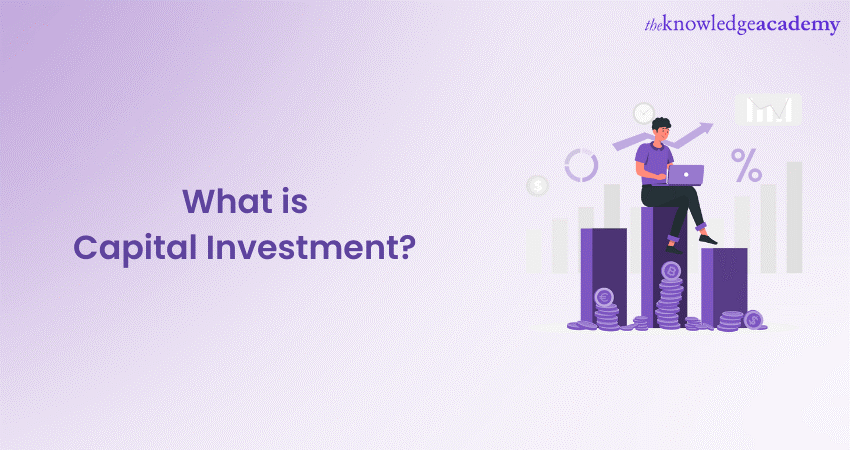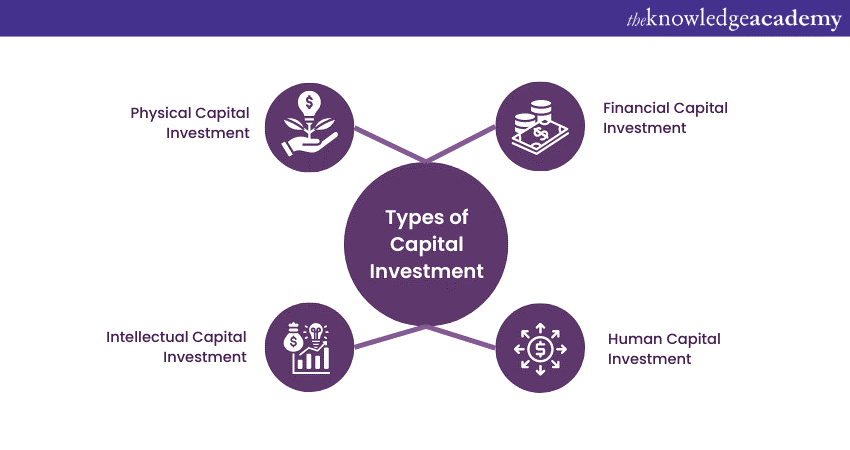We may not have the course you’re looking for. If you enquire or give us a call on 01344203999 and speak to our training experts, we may still be able to help with your training requirements.
Training Outcomes Within Your Budget!
We ensure quality, budget-alignment, and timely delivery by our expert instructors.

The concept of Capital Investment stands as a cornerstone of growth and innovation in modern business. From allocating funds for strategic projects to enhancing human skills and acquiring tangible assets, it drives the expansion and evolution of companies. In this blog, we will explore What is Capital Investment, unlocking financial success as we explore types, processes, and influencing factors. Read further to learn more!
Table of Contents
1) Understanding What is Capital Investment
2) How Capital Investment works?
3) Types of Capital Investment
4) Factors influencing Capital Investment decisions
5) Conclusion
Understanding What is Capital Investment
Capital Investment involves allocating financial resources toward projects, assets, or ventures to secure future benefits. It's a strategic decision-making process where businesses commit resources to enhance operations, expand market presence, or drive innovation. These investments manifest in diverse forms, from physical assets like machinery to financial instruments such as stocks and human development through training and protecting intellectual property.
They shape a company's growth trajectory, fortify competitiveness, and lay the groundwork for long-term success by maximising returns on allocated resources. Capital Investments often refer to acquiring permanent fixed assets like real estate and equipment, reported as non-current assets and subject to depreciation. Funding for such endeavours can stem from various sources, including cash reserves, loans, or stock issuance. Examples encompass land, buildings, machinery, equipment, and software.
Typically, businesses engage in Capital Investments for three primary reasons:
a) Firstly, to procure additional capital assets for expansion, allowing endeavours such as augmenting unit production, innovating new products, or enhancing overall value.
b) Secondly, Capital Investments facilitate implementing new technology or advancements in equipment, fostering increased operational efficiency and cost reduction.
c) Lastly, businesses undertake Capital Investments to replace existing assets that have reached their end-of-life. This could involve replacing high-mileage delivery vehicles or ageing laptop computers, ensuring continuity and effectiveness in operations.
Capital Investments are a strategic tool for businesses to grow, innovate, and optimise their operations through expansion, technological advancement, or asset maintenance and replacement.
How Capital Investment works?
Capital Investment is a strategic undertaking that involves careful planning, analysis, and execution to ensure the allocation of resources yields fruitful returns. The Investment Process can be broken down into several key stages:
Identification of investment opportunities
The process starts with the identification of opportunities aligning with a company's growth goals. This stage involves keen market observation, awareness of consumer demands, and tracking emerging technologies. Internal brainstorming and external collaborations uncover potential avenues for expansion, with industry expertise, creativity, and strategic foresight playing pivotal roles. Companies effectively identify opportunities to capitalise on untapped markets, novel products, or innovative solutions, fostering sustained growth.
Evaluation of potential investments
Following opportunity identification, a comprehensive evaluation using feasibility studies, risk assessments, and cost-benefit analyses becomes imperative. Businesses scrutinise the viability of each investment by utilising financial metrics like Net Present Value (NPV), Internal Rate of Return (IRR), and payback period. This evaluation aids decision-makers in understanding potential returns against inherent risks, facilitating informed choices and minimising the likelihood of investing in misaligned projects.
Decision-making and planning
Building on the evaluation, decision-makers must choose the most suitable investments. This involves prioritising projects, allocating budgets, and formulating implementation plans. Strategic alignment with company objectives ensures investments contribute to long-term success.
Effective planning establishes the foundation for optimal resource utilisation, early addressing potential challenges, and foreseeing the project's trajectory.
Implementation and monitoring
Moving into the implementation phase, investments require coordination, resource allocation, and adherence to timelines. Regular monitoring and reporting track progress against milestones, enabling timely intervention in case of deviations.
This phase ensures projects stay on course, resources are used efficiently, and intended outcomes are achieved, mitigating risks of delays or budget overruns.
Review and continuous improvement
Post-execution, a review phase commences, comparing actual outcomes with initial projections. It involves introspection into successes and areas for improvement. Valuable insights from successful projects inform future decisions, fostering a culture of adaptability and innovation.
Continuous improvement stems from a commitment to learning from successes and failures, contributing to an evolving and more effective Capital Investment process.
Types of Capital Investment
This section of the blog will expand on the different types of Capital Investment.

Physical Capital Investment
Physical Capital Investment involves acquiring and upgrading tangible assets that play a pivotal role in a company's daily operations and expansion plans. These assets encompass a wide spectrum, including land, buildings, machinery, equipment, and vehicles. Such Investments are aimed at improving production efficiency, expanding operational capacity, and enhancing the overall infrastructure.
For instance, a manufacturing company might opt to invest in state-of-the-art machinery to streamline processes and increase production output. By making prudent physical Capital Investments, businesses can fortify their operational foundation, remain competitive, and position themselves for sustained growth in their respective industries.
Financial Capital Investment
Financial Capital Investment revolves around allocating funds to various vehicles with the aim of generating returns or acquiring ownership interests. This encompasses Investments in stocks, bonds, mutual funds, and even startups. The objective is to achieve capital appreciation or earn regular income from these investments.
While financial Capital Investments offer the potential for significant financial gains, they also come with varying degrees of risk. Careful analysis, diversification, and a sound understanding of market trends are crucial when engaging in financial Capital Investments. They serve as a means for businesses to grow their wealth and meet their financial objectives.
Human Capital Investment
Human Capital Investment focuses on enhancing the skills, knowledge, and capabilities of a company's workforce. This is accomplished through training programs, educational initiatives, skill development, and employee engagement. By investing in human capital, businesses can promote a skilled and motivated workforce that drives innovation, productivity, and overall organisational success.
Employees equipped with up-to-date skills contribute to improved job performance, better customer service, and the ability to adapt to changing industry landscapes. In a competitive business environment, human Capital Investment is not just an expenditure but an invaluable strategy to ensure the growth and longevity of a company.
Intellectual Capital Investment
Intellectual Capital Investment involves creating, acquiring, and protecting intellectual property assets that provide a unique competitive advantage. This includes patents, trademarks, copyrights, and proprietary information. Such Investments enable companies to safeguard their innovations and distinct offerings, effectively establishing barriers to entry for competitors. Intellectual Capital Investments can encompass research and development efforts aimed at creating novel solutions or innovative products.
By strategically managing intellectual property, companies can differentiate themselves in the market, attract investors, and potentially generate revenue through licensing or partnerships. In today's knowledge-driven economy, intellectual Capital Investments are vital for sustaining a company's innovative edge and maintaining market leadership.
Elevate your investment prowess with our Investment Management Masterclass. Empower your financial decisions today!
Factors influencing Capital Investment decisions
Making sound Capital Investment decisions is a complex process influenced by a multitude of factors that shape the potential risks and rewards of each opportunity. These factors are pivotal in guiding decision-makers towards investments that align with the company's goals and contribute to its growth. Let's dive into the key considerations that influence Capital Investment decisions:
a) Investment objective: The intended purpose of an investment guides the allocation of funds, whether for short-term gains or long-term growth. This objective serves as the starting point in the decision-making process.
b) Return on Investment (ROI): Managers prioritise positive returns, aiming to invest limited funds in profitable assets or securities.
c) Return frequency: The periodic returns offered by an investment are crucial, with investors choosing based on financial needs, whether monthly, quarterly, semi-annual, or annual returns.
d) Risk analysis: Assessing the risk associated with an investment is essential, considering that each investor and company has a different risk appetite.
e) Maturity period or investment tenure: Investor decisions are influenced by the duration funds are locked in an investment, affecting both maturity and payback periods.
f) Tax implications: Tax liability linked to a specific asset or security is a significant determining factor, with investors avoiding heavily taxed opportunities.
g) Safety: Investments in assets adhering to regulatory frameworks and providing transparent financial disclosure are deemed safe, with government-backed assets considered the most secure.
h) Volatility: Market fluctuations can significantly impact investment returns, necessitating careful consideration.
i) Liquidity: Investors value the ability to access emergency funds, considering withdrawal restrictions and penalties when evaluating the liquidity of an asset or security.
j) Inflation rate: Investors seek opportunities where returns outpace the nation's inflation rate in financial management decisions.
Ready to master the art of Investment? Explore our Investment and Trading Training!
Conclusion
To sum it up, Capital Investment is the compass guiding growth and resilience in the domain of business. By navigating the investment landscape strategically, informed decisions pave the path to prosperity, driving innovation, market presence, and sustainable success. Hope we could answer all your queries about “What is Capital Investment”!
Ready to master Foreign Exchange Trading? Explore our comprehensive Foreign Exchange Training today!
Frequently Asked Questions

While Capital Investments hold significant potential for future returns and growth, it comes with its set of basic risks which require careful assessment. Partial of complete loss of invested capital owing to non-performance is one of the biggest risks associated with Capital Investments. Long-term investments are often time locked, making it difficult to quickly access the funds in case of an emergency Delays in project or sudden cost increases significantly affect the returns and value of investment too.

An investment decision is crucial as it determines the allocation of resources towards projects, assets, or ventures, shaping a company's trajectory. It impacts growth, innovation, and competitiveness. Effective investment decisions, based on careful analysis and strategic planning, contribute to long-term success by maximising returns. These decisions influence a company's ability to expand, adopt new technologies, and navigate market trends, ensuring it remains resilient and adaptable in the dynamic business landscape.

The Knowledge Academy takes global learning to new heights, offering over 30,000 online courses across 490+ locations in 220 countries. This expansive reach ensures accessibility and convenience for learners worldwide.
Alongside our diverse Online Course Catalogue, encompassing 17 major categories, we go the extra mile by providing a plethora of free educational Online Resources like News updates, Blogs, videos, webinars, and interview questions. Tailoring learning experiences further, professionals can maximise value with customisable Course Bundles of TKA.

The Knowledge Academy’s Knowledge Pass, a prepaid voucher, adds another layer of flexibility, allowing course bookings over a 12-month period. Join us on a journey where education knows no bounds.

The Knowledge Academy offers various Investment and Trading courses, including Foreign Exchange Training, Day Trading Masterclass and Forex Trading Masterclass. These courses cater to different skill levels, providing comprehensive insights into Forex Brokers.
Our Investment and Trading blogs covers a range of topics related to Investment and Trading, offering valuable resources, best practices, and industry insights. Whether you are a beginner or looking to advance your Investment and Trading skills, The Knowledge Academy's diverse courses and informative blogs have you covered.
Upcoming Advanced Technology Resources Batches & Dates
Date
 Cryptocurrency Trading Training
Cryptocurrency Trading Training
Fri 9th Aug 2024
Fri 8th Nov 2024







 Top Rated Course
Top Rated Course



 If you wish to make any changes to your course, please
If you wish to make any changes to your course, please


